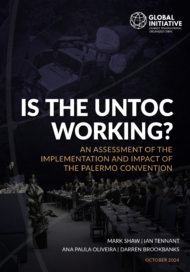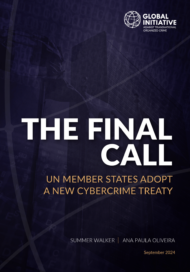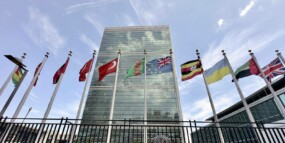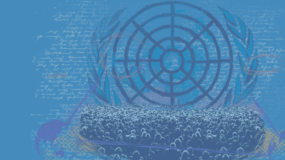Posted on 27 Nov 2024
The United Nations is on the verge of formally adopting a controversial new cybercrime convention that contains significant human rights risks. Its chances of success will depend on how strictly states implement its human rights safeguards, and more fundamentally whether the United States chooses to ratify it – a prospect that is becoming more uncertain with Donald Trump’s imminent return to office.
In August, member states finally agreed on the text of the treaty. It cleared another hurdle on 11 November 2024, with the General Assembly’s Third Committee recommending its adoption. But until it is formally adopted, its future is still in the balance. Despite rumours that the US might abstain or even vote against the treaty’s adoption, it seems that they, along with the rest of the UN member states, are content to see it continue towards formal adoption in December, when it enters its final vote at the General Assembly. The Biden administration, which approved it despite heavy industry pressure, is unlikely to stand in the way of this, although they are making no promises to ratify. Indeed, representatives at the November meeting made it clear that US ratification would only come when its first parties (probably Russia and other long-standing supporters of the convention) had proven that human rights safeguards are being respected in terms of the treaty.
The treaty’s journey to this point has been long and arduous. It was first proposed by Russia but also gained support from the BRICS nations and other developing countries. Despite initial Western concerns, the final version includes human rights protections – although some worry that these are not strong enough. On 9 August 2024, all UN members states agreed to the draft of the convention, following negotiating committee discussions since 2021. In the end, the treaty adopted was not in the form originally proposed by Russia, and does include human rights safeguards. However, it still contains some ambiguities that would give government agencies sweeping powers to access data and potentially provide cover to authoritarian regimes to persecute or repress persona non grata across borders.
A similar threat of increased surveillance and information control hangs over the US tech sector, which holds most of the world’s data, as the treaty could restrict the ability of companies to operate globally. US tech companies and some in civil society have therefore been fighting the treaty tooth and nail. They also argue that it could give authoritarian governments too much power to access data, claiming that its wide scope for criminalization poses risks to human rights and media freedom by facilitating mass surveillance and government repression. Since the treaty’s negotiating committee concluded its work, the US private sector has mobilized a concerted and high-level lobbying campaign, led by the Cybersecurity Tech Accord, to pressure the US to vote ‘no’ or abstain when the convention comes to the General Assembly for adoption. Given that the US joined the consensus at the November meeting, it looks increasingly unlikely that they will change tack before the final opportunity at the General Assembly in December. If the US does change its position in this way, the convention would lose much of its force and other Western countries may follow suit and abandon it.
The plot thickens with Trump’s incoming administration. The new cabinet has no skin in the negotiation process, and the Biden administration will leave before any US legislative process starts. The treaty may not immediately seem like something that would be top of the president-elect’s in-tray, but when domestic and international politics are added to the circumstances of its negotiation and imminent adoption process, the situation could jeopardize the chances of bringing the US into the fold. Trump is close to the private sector, and his new term in office may well harden the US position on the treaty, and therefore open a new chapter in the story of the embattled convention.
What’s more, Trump is not a champion of multilateralism per se, especially multilateralism of the sort that would put US private sector interests into question. The future president has previously shown no qualms in pulling the US out of multilateral processes, famously withdrawing from the Paris agreement on climate. Although the private sector used human rights as a reason to object to the treaty during the negotiation process, it is in fact the risks to the bottom line that will be the burning issue for the incoming administration.
The shape of the Trump administration would suggest the direction it might take. He has now added influential tech billionaire Elon Musk to his list of appointees. Although Musk’s ‘X’ was not involved in the convention negotiations (as Microsoft and Google were), the Tesla CEO’s track record, including his public disputes with Brazil (a key supporter of the treaty) and Australia, might indicate that he would not support multilateral efforts to extract data from tech companies, especially if they were seen as legacies of the Biden administration. Given Musk’s scepticism of international regulations, the treaty could face a further uphill battle.
The stakes are high. Without US participation and access to its vast pool of data, the treaty’s operational value will be close to zero. The treaty would at once be without access to the most rich and relevant data needed for it to have any criminal justice impacts, but, without US and potentially other Western participation, the monitoring of human rights and safeguarding against the worst impacts of how other states implement the treaty would also be weakened.
While countries such as Russia, China and Vietnam enthusiastically support the convention, others, including the EU and its states, and the UK, Australia, New Zealand, Canada, Switzerland and Liechtenstein have expressed reservations. Egypt and Iran meanwhile expressed reservations from the opposite perspective – that the treaty is overly focused on protecting human rights. Russia, and other key convention supporters – including Brazil, South Africa and India – were silent at the November session that moved the convention to its final stage in December.
In this context, the public silence around the treaty is telling. The UN Office on Drugs and Crime (UNODC) as the convention’s secretariat is avoiding touting its arrival until the official mandate comes down from the General Assembly in December. If adopted, the UNODC can look forward to a hefty regular budget increase, a new convention treaty body and associated capacity-building opportunities, including through a new training centre in Qatar. Without US participation and access to its data, or if only non-Western countries sign up, the picture changes dramatically.
Despite the lack of fanfare, the General Assembly looks certain, however, to adopt the treaty in December, and it is likely that the convention’s biggest supporters will quickly muster the 40 ratifications needed for it to enter into force. However, without US involvement, it might end up as little more than a paper tiger – although some countries, such as Russia, will still have a convention on paper, and might use it as cover to justify surveillance and international exchanges of information, with limited oversight.
While there is more need than ever to tackle cybercrime globally, this treaty could become another casualty of international politics and the changing winds in Washington DC. With Trump’s attitude to multilateralism and the tech industry’s opposition to the treaty, the chance of US membership may slip away, leaving the world’s newest multilateral treaty without its most crucial player. As such, human rights and digital privacy advocates who have campaigned against the treaty alongside the private sector may find themselves a new and unlikely ally in Trump.



